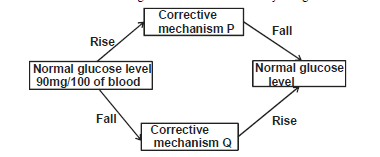-
State any two differences between an ovum and a sperm.
(Solved)
State any two differences between an ovum and a sperm.
Date posted:
May 24, 2019
.
Answers (1)
-
The diagram below represents the nitrogen cycle.
a) State the process labelled.
A
D
b) Name the compound represented by B.
c) Name the group of organisms labelled...
(Solved)
The diagram below represents the nitrogen cycle.

a) State the process labelled.
A
D
b) Name the compound represented by B.
c) Name the group of organisms labelled C.
d) i) Name the group of plants which promote process A.
ii) State the part of the plant where process A takes place.
e) How would excess pesticides in the soil interfere with process A.
Date posted:
May 24, 2019
.
Answers (1)
-
Give a reason why lack of roughage in the diet often leads to constipation.
(Solved)
Give a reason why lack of roughage in the diet often leads to constipation.
Date posted:
May 23, 2019
.
Answers (1)
-
Explain how the process of evolution may result to the formation of a new species.
(Solved)
Explain how the process of evolution may result to the formation of a new species.
Date posted:
May 23, 2019
.
Answers (1)
-
In an experiment to investigate an aspect of digestion, two test tubes A and B were set up as shown in the diagram below.
a) What...
(Solved)
In an experiment to investigate an aspect of digestion, two test tubes A and B were set up as shown in the diagram below.

The test tubes were left in the bath for 30 minutes. The contents of each test tube was then tested for starch using iodine solution.
a) What was the aim of the experiment?
b) What results were expected in test tube A and B.
c) Account for the results you have given in (b) above in test tube A and B.
d) Why was the set up left at 37°C?
Date posted:
May 23, 2019
.
Answers (1)
-
The diagram below represents a mammalian embryo and associated maternal structures.
a) Name the parts labelled R and S.
b) State THREE adaptation of part Q...
(Solved)
The diagram below represents a mammalian embryo and associated maternal structures.

a) Name the parts labelled R and S.
b) State THREE adaptation of part Q to its functions.
c) i) Name the part labelled T.
ii) What is the function of part T?
Date posted:
May 23, 2019
.
Answers (1)
-
The diagram below shows how blood glucose in mammalian body is regulated.
a) Explain what happens during corrective mechanism P.
b) Name two organs involved in...
(Solved)
The diagram below shows how blood glucose in mammalian body is regulated.

a) Explain what happens during corrective mechanism P.
b) Name two organs involved in corrective mechanisms P and Q.
c) State two reasons why glucose level should be maintained constant.
d) What is osmoregulation?
Date posted:
May 23, 2019
.
Answers (1)
-
A woman with normal skin pigmentation was married to a man with normal skin pigmentation. They had two children, one
with normal skin colour, genotype AA,...
(Solved)
A woman with normal skin pigmentation was married to a man with normal skin pigmentation. They had two children, one
with normal skin colour, genotype AA, while the other one was an albino.
a) State the couple's genotypes.
b) Using a genetic cross, show how they were able to produce an albino and a normal skinned child.
c) What is the percentage of their third child being an albino?.
d) State one way one could easily identify an albino.
Date posted:
May 23, 2019
.
Answers (1)
-
Give two reasons why potato tubers become sweeter after boiling.
(Solved)
Give two reasons why potato tubers become sweeter after boiling.
Date posted:
May 23, 2019
.
Answers (1)
-
An experiment was set up to demonstrate the necessity of carbon (IV) oxide for
photosynthesis in a certain green plant as shown below. The plant was...
(Solved)
An experiment was set up to demonstrate the necessity of carbon (IV) oxide for
photosynthesis in a certain green plant as shown below. The plant was first kept
darkness for 48 hours before the experiment.

a), Why was the plant kept in darkness for 48 hours before the start of this experiment.
b), What was the role of sodium hydroxide?
ci)What was the results shown by the leaf in the flask when it was tested for presence of starch after
the set up was exposed to light for a day?.
ii), Give reasons for your answer in (c) I above
d. Suggest a control for this experiment.
e), Name other two limiting factors in this experiment.
Date posted:
May 22, 2019
.
Answers (1)
-
The diagram below shows some components of a light microscope.
a), Name the parts labeled
K –
M –
b), State the functions of
P –
Q –
c) A...
(Solved)
The diagram below shows some components of a light microscope.

a), Name the parts labeled
K –
M –
b), State the functions of
P –
Q –
c) A student was viewing a prepared slide of a plant cell under high power microscope.
The features of the cell were blurred. Which one of the labeled parts of the microscope
would the student use to obtain; A sharper outline of the features
Date posted:
May 22, 2019
.
Answers (1)
-
The diagram below shows a phenomenon which occurs during cell division.
a) Identify the stage of cell division in which this phenomenon occurs.
b) State the...
(Solved)
The diagram below shows a phenomenon which occurs during cell division.

a) Identify the stage of cell division in which this phenomenon occurs.
b) State the importance of the phenomenon taking place in the part labeled B.
Date posted:
May 22, 2019
.
Answers (1)
-
The diagram below represents a transverse section of a plant part. Study it and answer the questions that
follow.
a)Name the class in which the plant belongs.
b)...
(Solved)
The diagram below represents a transverse section of a plant part. Study it and answer the questions that
follow.

a)Name the class in which the plant belongs.
b) Give a reason for answer (a) above.
c) State one adaptation for the structures labeled X to their functions.
Date posted:
May 22, 2019
.
Answers (1)
-
What are the names of modified leaves enclosing bougainvillea flowers whose function is to
attract insect pollinators?
(Solved)
What are the names of modified leaves enclosing bougainvillea flowers whose function is to
attract insect pollinators?
Date posted:
May 22, 2019
.
Answers (1)
-
Equal amounts of crushed Irish potato were placed in equal volumes of hydrogen peroxide solution
at indicated pH. The volume of the gas produced was measured...
(Solved)
Equal amounts of crushed Irish potato were placed in equal volumes of hydrogen peroxide solution
at indicated pH. The volume of the gas produced was measured and recorded as shown in the table
below.

(a) Name the gas that was produced.
(b)Account for the difference in the volume of the gas produced in pH 4.0 and pH 9.0
Date posted:
May 22, 2019
.
Answers (1)
-
Name the branch of Biology that involves the study of Organisms for the sake of classifying them.
(Solved)
Name the branch of Biology that involves the study of Organisms for the sake of classifying them.
Date posted:
May 22, 2019
.
Answers (1)
-
Explain the reason why growing grass dries when salt is sprinkled on it?
(Solved)
Explain the reason why growing grass dries when salt is sprinkled on it?
Date posted:
May 4, 2019
.
Answers (1)
-
Name two chemicals used to immobilize highly mobile animals during collection of small animals
(Solved)
Name two chemicals used to immobilize highly mobile animals during collection of small animals
Date posted:
April 28, 2019
.
Answers (1)
-
List down the three theories that explain the opening and closing of stomata
(Solved)
List down the three theories that explain the opening and closing of stomata.
Date posted:
April 26, 2019
.
Answers (1)
-
State two functions of mucus produced along the alimentary canal
(Solved)
State two functions of mucus produced along the alimentary canal.
Date posted:
April 26, 2019
.
Answers (1)